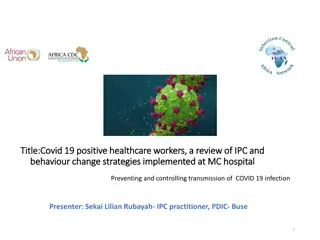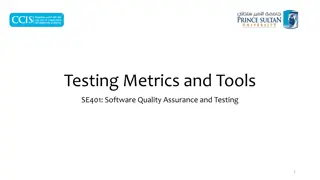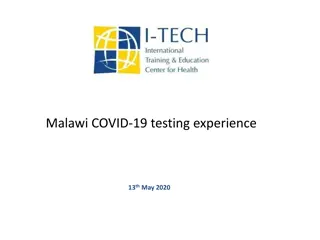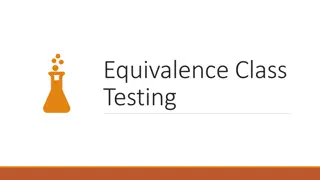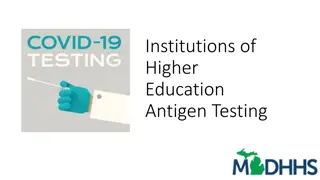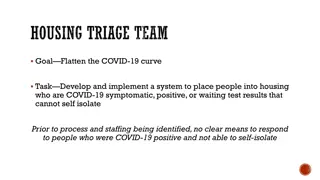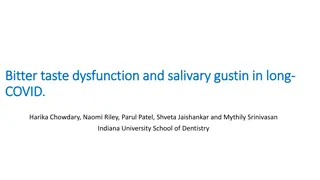Optimizing COVID-19 Testing Strategies to Conserve Resources
Accurate and extensive testing of populations for COVID-19 is crucial, but resources like tests, trained personnel, and lab time are limited. This study explores innovative mechanisms like group testing to maximize the benefits from limited resources and achieve testing objectives effectively.
Download Presentation

Please find below an Image/Link to download the presentation.
The content on the website is provided AS IS for your information and personal use only. It may not be sold, licensed, or shared on other websites without obtaining consent from the author.If you encounter any issues during the download, it is possible that the publisher has removed the file from their server.
You are allowed to download the files provided on this website for personal or commercial use, subject to the condition that they are used lawfully. All files are the property of their respective owners.
The content on the website is provided AS IS for your information and personal use only. It may not be sold, licensed, or shared on other websites without obtaining consent from the author.
E N D
Presentation Transcript
RESOURCE-OPTIMAL TESTING MECHANISMS FOR COVID-19 Francisco Marmolejo-Coss o Joint work with: J. Jonnerby, E. Lock, C. Ramsay, M. Shukla, D. Sridhar University of Oxford Mechanism Design for Social Good (MD4SG)
MAIN PROBLEM Accurate and extensive testing of population required to combat Covid-19 Resources can be extremely limited: Tests Trained personnel Lab time How do we maximise the benefit of these limited resources?
TESTING OBJECTIVES Minimise propagation of virus i.e. prioritise those susceptible or likely to spread Minimise impact of unecessary self-isolation Essential workers Those without the economic means to self-isolate
GROUP TESTING Recently, researchers in Israel have suggested that Covid-19 tests are sensitive enough to pool 32-64 samples together If a single individual is sick, test is positive If all individuals are healthy, test is negative Has potential to drastically reduce the number of tests needed to tackle objectives from before There is a substantial literature on the subject
UNIFORM GROUP TESTING The simplest way of group testing Suppose we have a population of size ? The testing protocol has two parameters: ?: the number of tests allocated to population ?: the granularity of tests (i.e. group sizes used) Test ? disjoint groups of size ?
LOW GRANULARITY TESTING We assume a testing budget: ? Population of ? individuals Belong to ? categories Each category, ??has the following characteristics: ??: baseline probablity of infection ??connectivity / exposure ??: cost of self-isolation ??: number of individuals in the class
LOW GRANULARITY TESTING Consider testing strategies that consist of disjoint uniform group testing strategies for each category A feasible testing protocol consists of: ??: number of tests allocated to ?? ??: granularity of uniform group testing within ?? Constraints: ???? ?? ?? ? = 64 ?? ?
CONTAGION MODEL AND SELF- ISOLATION POLICY We assume a single step of contagion Initially individuals of ??are infected with iid probability ?? Subsequently, the population is tested according to feasible variable granularity testing strategy Self-isolation policy assumptions: If individual is in positive group test, then forced to self-isolate If individual is negative test, or untested, no change in behaviour
OBJECTIVES Minimise propagation of virus i.e. prioritise those susceptible or likely to spread In practice, this means large ??and ??values Minimise impact of unecessary self-isolation i.e. prioritise those with large ??values Essential workers Those without the economic means to self-isolate
THE OPTIMISATION PROBLEM ??= ?? ????, the untested individuals in ?? ? 0,1 is a relative weight of each portion of the objective
POSSIBLE SCENARIO Village of 10,000 people 20 key healthcare workers 480 regular marketplace workers 9,500 other townsfolk 100 tests at your disposal Can make use of group tests of size at most 64 What s the best strategy?
CURRENT PRACTICES If conscious of health workforce, allocate 20 tests For all others, test if individual is already showing symptoms Unfortunately these tests are not very informative There is an inherent bias in results Many cases go un-noticed
UNIFORM GROUP TEST ON WHOLE POPULATION Choose a random assignment of 100 groups of size 64 from village Place these individuals in group for testing Benefits: Covers 64% of the population Can estimate prevalence of virus Drawbacks: May unnecessarily self-isolate healthcare workers May not necessarily test an infected marketplace worker
VARIABLE GROUP TESTING We consider the case were cost of self-isolation for marketplace workers is high Possible testing strategy: 20 tests for individually testing healthcare workers 20 tests of group size 24 (480 individuals tested) for marketplace workers 60 tests of group size 64 for randomly selected groups of townsfolk (3840 individuals tested) If cost of self-isolation for marketplace workers is low, can bring the granularity down in their segment while still covering their numbers. This frees up tests for the townsfolk
BREAKING THE GROUP TESTING LIMIT Individuals with highly correlated infection rates do not need to be tested separately Household members fall in this category, and a single test from an individual in the household should suffice to determine whether all or none are infected If the household is the basic unit, pooled tests aggregate over households In our village example, if the average household is of 3 members, then 50 pooled household tests suffice to cover entire townsfolk segment of population
NEXT STEPS Different objectives (? values) at different stages Incorporate more realistic modeling Consider the evolution of infection as a function of policy Incorporate more advanced group testing techniques Understand intricacies of applying these methods around the world Get help with trials to get the project off the ground and used in practice
THANK YOU FOR LISTENING! Email: marmolejo.francisco@gmail.com




